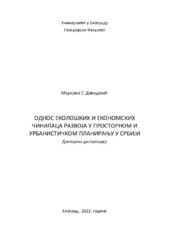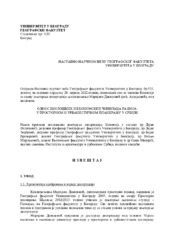Приказ основних података о дисертацији
Однос еколошких и економских чинилаца развоја у просторном и урбанистичком планирању у Србији
Relationship between ecological and economic factors of development in spatial and urban planning in Serbia
| dc.contributor.advisor | Filipović, Dejan | |
| dc.contributor.other | Đorđević, Dejan | |
| dc.contributor.other | Vračarević, Bojan | |
| dc.contributor.other | Mijušković, Veljko | |
| dc.contributor.other | Milijić, Saša | |
| dc.creator | Azdejković, Marijana | |
| dc.date.accessioned | 2023-02-24T19:42:39Z | |
| dc.date.available | 2023-02-24T19:42:39Z | |
| dc.date.issued | 2022-09-21 | |
| dc.identifier.uri | https://eteze.bg.ac.rs/application/showtheses?thesesId=8987 | |
| dc.identifier.uri | https://fedorabg.bg.ac.rs/fedora/get/o:28078/bdef:Content/download | |
| dc.identifier.uri | https://plus.cobiss.net/cobiss/sr/sr/bib/80885001 | |
| dc.identifier.uri | https://nardus.mpn.gov.rs/handle/123456789/21215 | |
| dc.description.abstract | Рад је условно подељен на три велике целине. У првом делу рада даје се теоријско објашњење појмова еколошке димензије простора, затим економске димензије простора, као и земљишне политике сагледавањем тржишта и његове везе са планирањем (просторним и урбанистичким), као економским сегментом кроз који ће се посматрати утицај планова на развој простора и формирање тржишне цене земљишта. Кроз прва три поглавља рада дат је теоријски приступ теми, са објашњењем појмова и освртом на светску политику и инострана тумачења појмова еколошки и економски развој кроз просторно сагледавање са аспекта различитих погледа и различитих методологија које се примењују у свету како данас тако и у протеклом времену. У трећем поглављу рада приказан је једним делом и економски аспект урбаног развоја сагледан кроз развој градског саобраћаја са критичким освртом на исти. У другом делу рада, односно четвртом поглављу посебно се обрађује однос еколошких и економских чинилаца развоја у просторном и урбанистичком планирању у Србији, где се наводе јасни примери из простора на којима се сукоб економије и екологије најбоље осликава што кроз развијене што кроз неразвијене земље, такође се даје осврт на теорију одрживост развоја и његове примене на регионалном нивоу. У трећем делу рада, односно петом поглављу дисертације приказује се емпиријска анализа простора Националног Парка Копаоник и то следећих туристичких зона Јарам, Сребрнац и Рендара. (Исте територијално припадају општини Брус, а чине саставни део територије НП Копаоник, и анализиране су за период од 2000 године преко 2007 године до 2017 године, као иницијалних година када је овај простор доживео промене од пољопривредног земљишта претворен у грађевинско израдом планских докумената, а након тога изградњом комуналне и друге инфраструктуре, па до изградње самих објеката на том подручју, што је неминовно утицало на промене у еколошком смислу овог простора и исти се сагледавао кроз загађеност ваздуха, загађеност воде, загађеност земљишта, покривеност шумом - четинарима, снежни покривач - дебљина и време задржавања, учесталост - интензитет саобраћаја кроз ове локације Јарам, Сребрнац и Рендара), у односу на стање истих индикатора на нивоу Србије. У последњем делу рада је закључак са прилозима истраживања и захтевима и упитницима који слати Јавним институцијама. Негативне последице људског утицаја и индустрије на животну средину превладале су у развоју транзиционих економија толико да су створиле услове еколошке кризе која је у стању да природну средину учини непогодном за живот човека. Суочене с проблемима раста и његовим социјалним последицама, транзиционе земље међу којима је и Србија, настоје по сваку цену да отворе нове просторе раста у новим секторима, штетећи тиме основама самог система. Њихова основна нада лежи у новим технологијама као подстицају животности система, а не у промени социјалних односа. У томе им помаже и еколошка критика која у највећем делу захвата последице, а не социјалне узроке у самом систему ( демографску слику). Проблем односа економије и екологије у простору спада у групу савремених проблема данашњег човечанства. Економски просперитет је један од главних узрока настанка овог проблема, јер је у природи човека да се бори за опстанак, за бољи и квалитетнији живот, а при томе неизбежно користи благодети природе. Пошто се технологија унапређивала, општи развој растао, самим тим и људски ,,апетити,, су се повећавали, и данас су на завидном нивоу. Природни ресурси су на граници искоришћености, проблем озонских рупа, киселих киша, константно загревање планете само су неки од проблема који муче данашње човечанство. Концепт одрживог развија долази у право време са покушајем да се расипничка природа људи коначно обузда преко својих принципа који теже заштити и очувању природних богатстава, вредности и добара са веома умереним коришћењем истих, међутим у овим раду поставиће се питање у којој мери је овај концепт спроводљив, и у који мери и на који начин се може применити и препознати на територији једне транзиционе земље попут Србије. | sr |
| dc.description.abstract | Тhe paper is conditionally divided into three large units. The first part of the paper provides a theoretical explanation of the concepts of ecological dimension of space, then the economic dimension of space, as well as land policy by considering the market and its relationship with planning (spatial and urban), as an economic segment through which to observe the impact of plans on spatial development and formation market prices of land. The first three chapters of the paper give a theoretical approach to the topic, with an explanation of the concepts and a review of world politics and foreign interpretations of the concepts of ecological and economic development through spatial observation from the aspect of various errors and different methodologies applied in the world today and in the past. The third chapter of the paper presents in one part the economic aspect of urban development viewed through the development of urban transport with a critical review of the same. The second part of the paper, ie the fourth chapter deals with the relationship between the ecological and economic factors of development in spatial and urban planning, where clear examples are given from the areas where the conflict between economy and ecology is best portrayed through divided and underdeveloped countries, sustainability of development and its application at the regional level. The third part of the paper, ie the fifth chapter of the dissertation, presents an empirical analysis of the area of the Kopaonik National Park, namely the following tourist zones Jaram, Srebrnac and Rendara. They territorially belong to the municipality of Brus, and form an integral part of the territory of NP Kopaonik, and were analyzed for the period from 2000 through 2007 to 2017, as the initial years when this area underwent changes from agricultural land turned into construction by planning documents. by building communal and other infrastructure, until the construction of the facilities in the area, which inevitably affected the changes in the ecological sense of this area and it was seen through air pollution, water pollution, soil pollution, forest cover - conifers, snow cover - thickness and retention time, Frequency - traffic intensity through these locations Jaram, Srebrnac and Rendara. In the last part of the paper, there is a conclusion with research attachments and requests and inquiries to be sent to public institutions. The negative consequences of human impact on the industry and the environment are overcome in the development of transition economies so that they create the conditions of ecological crisis that is able to make the environment unsuitable for human life. Faced with the problems of growth and its social consequences, transition countries including Serbia, trying at all costs to open new areas of growth in new sectors, there by damaging the basics of the system. Their main hope lies in new technologies as stimulating the vitality of the system, not changing social relations. That helps and environmental criticism in most of the effects of interventions, rather than social causes in the system. The relationship between the economy and ecology of the area belongs to the group of contemporary problems of humanity today. Economic prosperity is one of the main causes of this problem, because it is human nature to fight for survival, for better and better quality of life, and when it inevitably uses the benefits of nature. Since the technology is promoted, the general development grew, hence the human appetite is increasing, and today are at a high level. The natural resources are on the verge of usage, the problem of ozone hole, acid rain, constantly warming are just some of the problems that plague today's humanity. The concept of sustainable development comes at the right time with an attempt to wasteful nature people finally rein over his principles who seek the protection and preservation of natural resources, securities and assets with a moderate use of the same, but in this paper will put the question to what extent this concept is implementable, and to which extent and in what way it can be applied to identify the territory of a transitional country like Serbia. | en |
| dc.format | application/pdf | |
| dc.language | sr | |
| dc.publisher | Универзитет у Београду, Географски факултет | sr |
| dc.rights | openAccess | en |
| dc.source | Универзитет у Београду | sr |
| dc.subject | екологија | sr |
| dc.subject | ecology | en |
| dc.subject | economy | en |
| dc.subject | market | en |
| dc.subject | sustainable development | en |
| dc.subject | economic effects | en |
| dc.subject | economic instruments | en |
| dc.subject | environmental responsibility | en |
| dc.subject | transitional economies | en |
| dc.subject | the value of the environment | en |
| dc.subject | sustainable urban development | en |
| dc.subject | strategy development | en |
| dc.subject | regional planning level | en |
| dc.subject | political processes | en |
| dc.subject | економија | sr |
| dc.subject | тржиште | sr |
| dc.subject | одрживи развој | sr |
| dc.subject | економски ефекти | sr |
| dc.subject | економски инструменти | sr |
| dc.subject | еколошка одговорност | sr |
| dc.subject | транзициона економија | sr |
| dc.subject | вредност животне средине | sr |
| dc.subject | одрживи урбани развој | sr |
| dc.subject | стратегије развоја | sr |
| dc.subject | регионални ниво планирања | sr |
| dc.subject | политички процеси | sr |
| dc.title | Однос еколошких и економских чинилаца развоја у просторном и урбанистичком планирању у Србији | sr |
| dc.title.alternative | Relationship between ecological and economic factors of development in spatial and urban planning in Serbia | en |
| dc.type | doctoralThesis | |
| dc.rights.license | ARR | |
| dc.identifier.fulltext | http://nardus.mpn.gov.rs/bitstream/id/149679/Disertacija_13299.pdf | |
| dc.identifier.fulltext | http://nardus.mpn.gov.rs/bitstream/id/149680/ReferatDavidovic.pdf | |
| dc.identifier.rcub | https://hdl.handle.net/21.15107/rcub_nardus_21215 |



